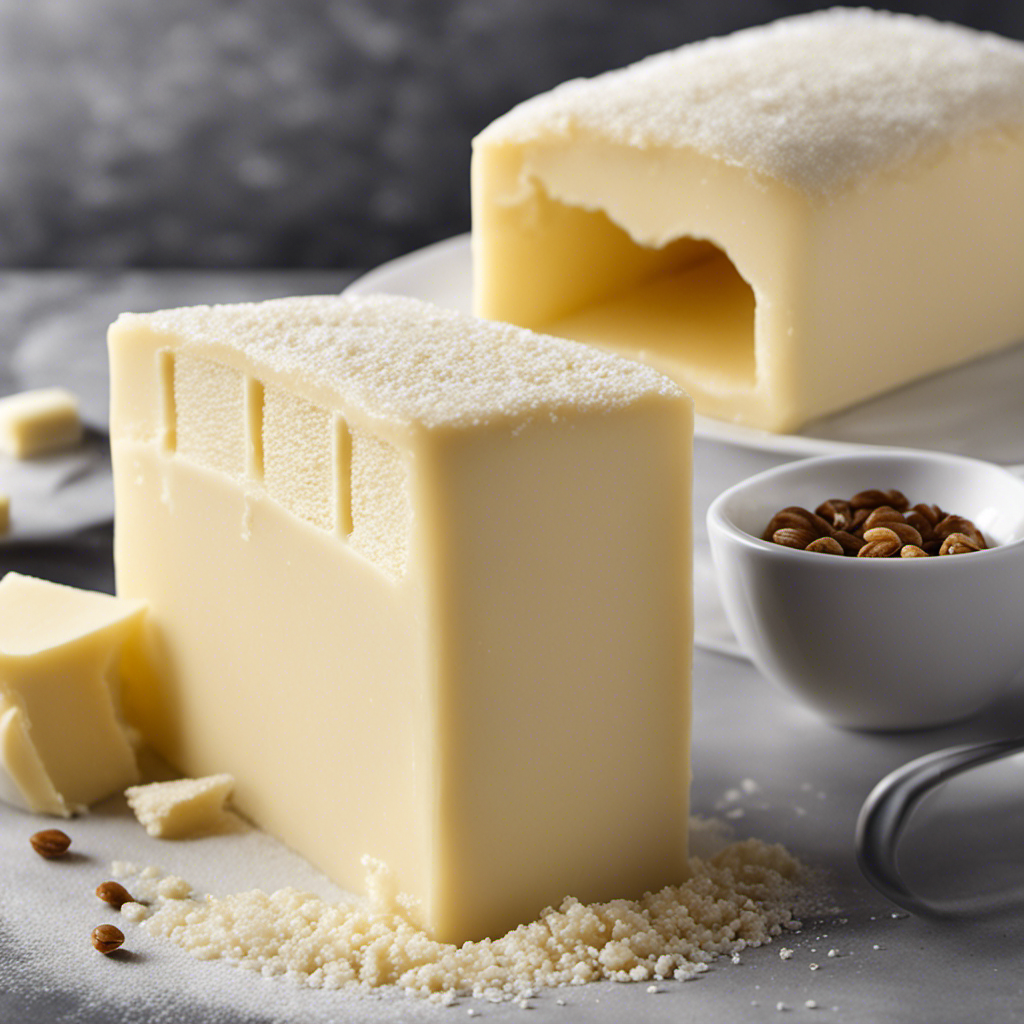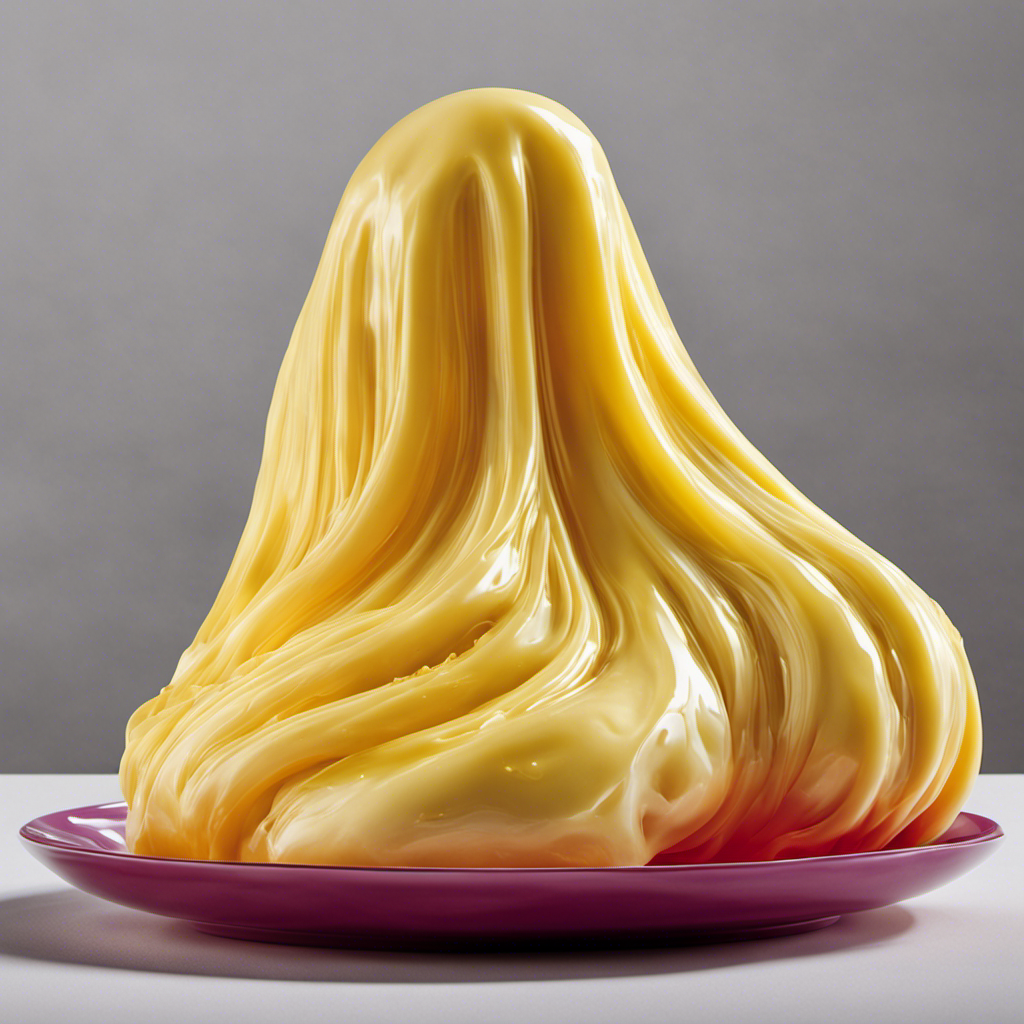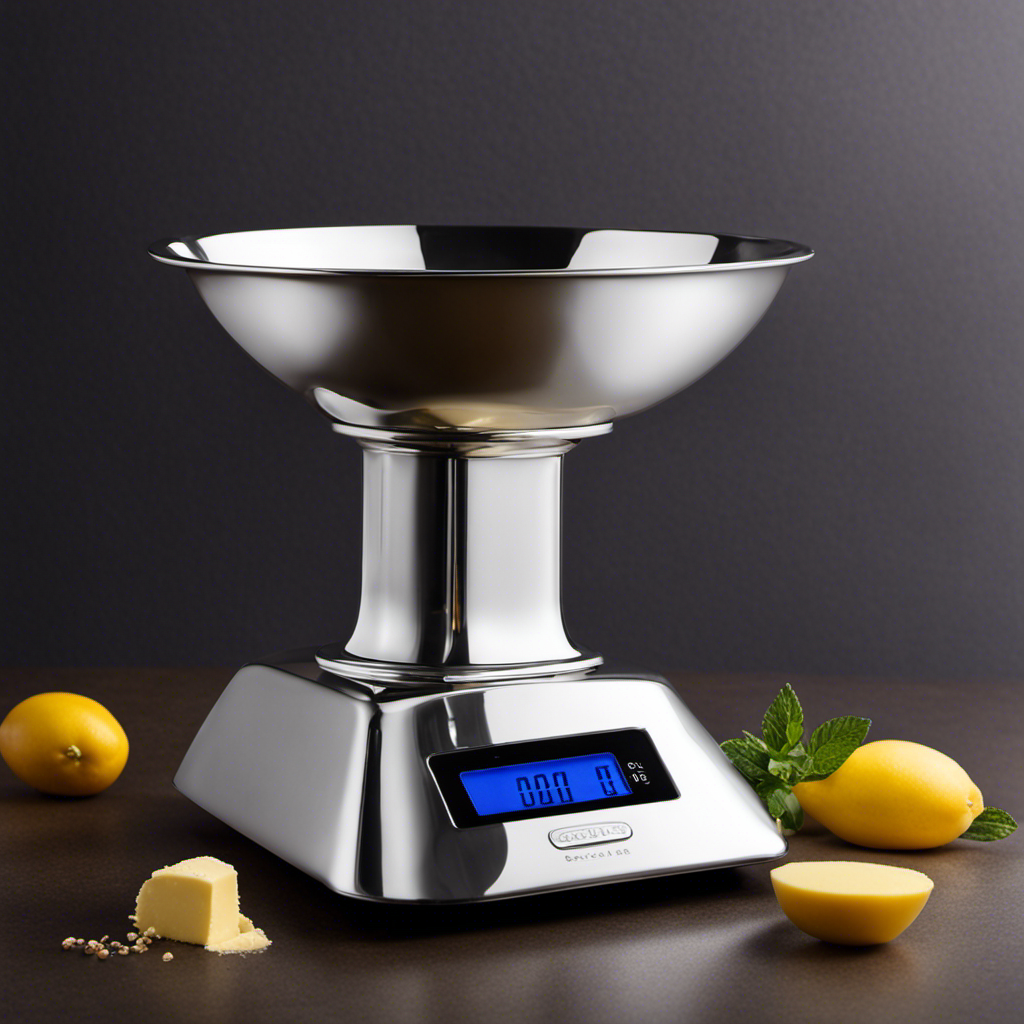Just like a pinch of salt enhances the flavors of a dish, salted butter adds a savory kick to our beloved recipes. Have you ever considered how much salt is actually in a stick of this tasty dairy product?
In this article, I will explore the role of salt in butter, delve into the factors that affect salt levels, and provide insights on managing our salt intake. Join me as we unravel the mystery of salted butter and discover how it impacts our health.
Key Takeaways
- Salt enhances the flavor of butter and brings out its natural flavors.
- Salt acts as a preservative, extending the shelf life of butter.
- The sodium content in salted butter is relatively low compared to other high-sodium foods.
- It’s important to consume salted butter in moderation to avoid excessive sodium intake.
The Role of Salt in Butter
Salt plays a crucial role in enhancing the flavor of butter. When salt is added to butter, it not only adds a savory taste but also brings out the natural flavors of the butter.
The benefits of salt in butter are numerous. Firstly, salt acts as a flavor enhancer, making the butter taste richer and more delicious. It also helps to balance out the sweetness in baked goods, creating a perfect harmony of flavors.
Additionally, salt in butter acts as a preservative, extending its shelf life and preventing spoilage. The impact of salt on flavor in butter is undeniable. Without salt, butter would lack depth and complexity, resulting in a bland and uninspiring taste.
Understanding Salt Content in Salted Butter
There are several misconceptions surrounding salted butter that need to be addressed.
It is often believed that salted butter is unhealthy due to its high salt content, but this is not necessarily true. While excessive consumption of salted butter can have negative health implications, it can still be enjoyed in moderation as part of a balanced diet.
However, for those who are looking for alternatives, there are various unsalted butter options available that provide the same creamy texture without the added salt.
Salted Butter Misconceptions
One common misconception about salted butter is that it contains a significant amount of sodium. However, this is not entirely true. While salted butter does indeed contain salt, it does not have as much sodium as one might think. In fact, the sodium content in salted butter is relatively low compared to other foods that are commonly high in sodium.
To help you better understand the truth about salted butter, here are a few key points to consider:
-
Salted butter flavor: The addition of salt to butter enhances its flavor, giving it a savory and slightly salty taste that can elevate the overall taste of various dishes.
-
Salted butter recipes: Salted butter is commonly used in recipes where a touch of saltiness is desired, such as in baked goods like cookies and cakes, as well as in savory dishes like pasta sauces and sautéed vegetables.
-
Sodium content: While the exact amount of sodium in salted butter can vary depending on the brand, on average, one tablespoon of salted butter contains about 90 milligrams of sodium. This is relatively low compared to other sources of sodium in our diet.
-
Moderation is key: Like with any food, it’s important to consume salted butter in moderation. While it does add flavor to dishes, excessive intake of sodium can have negative health effects, so it’s best to enjoy salted butter in moderation as part of a balanced diet.
Health Implications of Salted Butter
To maintain a healthy diet, it’s important to be mindful of the sodium content in salted butter. While butter is a staple in many households, the addition of salt can significantly increase your sodium intake. Excessive sodium intake has been linked to numerous health risks, including high blood pressure, heart disease, and stroke. To understand the sodium content in salted butter, refer to the table below:
| Brand | Serving Size (1 Tbsp) | Sodium (mg) |
|---|---|---|
| A | 100 | 90 |
| B | 100 | 120 |
| C | 100 | 80 |
| D | 100 | 110 |
As you can see, the sodium content varies among different brands, but it’s important to note that even small amounts can contribute to your daily sodium intake. To minimize health risks, it’s advisable to limit your consumption of salted butter and opt for unsalted alternatives or healthier spreads with lower sodium content.
Alternatives to Salted Butter
If you’re looking for a healthier alternative to salted butter, you might consider trying unsalted spreads or other low-sodium options. These alternatives can provide the same creamy texture and rich flavor without the added salt. Here are some options to consider:
-
Salt-free spreads: These spreads are specifically made without any added salt, making them a great choice for those looking to reduce their sodium intake.
-
Herb-infused spreads: These spreads are flavored with herbs and spices, such as garlic or dill, to enhance the taste without the need for salt.
-
Nut-based spreads: Spreads made from nuts, like almond or cashew butter, can add a delicious flavor to your dishes without the use of salt.
-
Fruit-based spreads: Fruit spreads, like apple or pumpkin butter, can provide a natural sweetness and flavor boost to your meals.
By exploring these alternatives, you can enjoy the taste of butter while avoiding the high sodium content found in salted butter.
Now, let’s dive into the factors that affect the salt levels in salted butter.
Factors Affecting Salt Levels in Salted Butter
The amount of salt in a stick of salted butter can vary due to several factors. One of the main factors is the brand or manufacturer of the butter. Different brands may have different recipes or formulations, resulting in varying levels of salt.
Additionally, the region where the butter is produced can also impact the salt levels. For example, butter made in coastal regions may have a slightly higher salt content due to the influence of sea salt in the air.
Another factor is personal preference. Some consumers prefer a higher salt content, while others prefer a milder taste.
It’s important to note that salt plays a crucial role in enhancing the flavor of butter. It helps to balance the richness of the butter and adds a savory note to dishes. However, excessive salt levels can overpower other flavors, so finding the right balance is key.
Comparing Salted Butter to Unsalted Butter
Now that we have discussed the factors that affect salt levels in salted butter, let’s compare salted butter to unsalted butter.
It’s important to consider both the nutritional value and taste when making this comparison.
-
Nutritional Value:
-
Salted butter generally contains more sodium due to the added salt.
-
Unsalted butter, on the other hand, has a lower sodium content.
-
Taste Comparison:
-
Salted butter has a distinct savory taste due to the added salt.
-
Unsalted butter has a milder, sweeter flavor.
When deciding between salted and unsalted butter, it ultimately depends on personal preference and dietary needs. If you are watching your sodium intake, unsalted butter may be a better choice. However, if you enjoy the savory taste and want to add a bit more flavor to your dishes, salted butter can be a great option.
Health Implications of Consuming Salted Butter
When choosing between salted and unsalted butter, you should consider the potential health implications of consuming butter with added sodium. Salted butter contains higher levels of sodium compared to unsalted butter. Excessive sodium intake has been linked to various health risks, such as high blood pressure, heart disease, and stroke. It is important to monitor your sodium intake and make informed choices about the foods you consume. To illustrate the difference in sodium content between salted and unsalted butter, consider the following table:
| Butter Type | Sodium Content (per 100g) |
|---|---|
| Salted Butter | 727mg |
| Unsalted Butter | 2mg |
As shown in the table, salted butter contains significantly more sodium compared to unsalted butter. Therefore, if you are concerned about your sodium intake and potential health risks, opting for unsalted butter may be a better choice.
Tips for Managing Salt Intake With Salted Butter
To manage your sodium intake while still enjoying the flavor of salted butter, you can try using smaller amounts and pairing it with low-sodium ingredients. Here are some tips for managing salt cravings and reducing your sodium intake:
-
Opt for unsalted butter: By choosing unsalted butter, you have complete control over the amount of salt you add to your dishes.
-
Use herbs and spices: Enhance the flavor of your dishes by incorporating herbs and spices instead of relying solely on salted butter.
-
Experiment with different fats: Explore alternatives to butter, such as olive oil or avocado, which offer a different taste profile and lower sodium content.
-
Read labels: Be mindful of the sodium content in other ingredients you’re using alongside salted butter, such as bread or crackers.
Frequently Asked Questions
Is There a Difference in Taste Between Salted and Unsalted Butter?
There is a noticeable taste difference between salted and unsalted butter. Salted butter has a slightly savory flavor, enhancing the taste of dishes. It is also important to consider the cooking differences when using either type of butter.
How Does the Salt Content in Salted Butter Affect Its Shelf Life?
The salt content in salted butter affects its shelf life by acting as a preservative. It reduces the growth of bacteria and mold, extending the butter’s freshness. Additionally, salt enhances the texture of butter by altering its water-holding capacity.
Can the Salt Content in Salted Butter Vary Between Different Brands?
The salt content in salted butter can vary between different brands, resulting in different levels of salt in the final product. This difference in salt levels can have an impact on the flavor of the butter.
What Are the Alternatives to Salted Butter for Those Looking to Reduce Their Salt Intake?
There are many alternatives to salted butter for those looking to reduce salt intake. Substitutes like unsalted butter, olive oil, avocado, or coconut oil can provide similar benefits while lowering sodium intake.
Are There Any Health Benefits Associated With Consuming Salted Butter in Moderation?
There are health risks associated with consuming salted butter in moderation due to its high sodium content. The recommended daily intake of sodium is 2,300 mg, and a stick of salted butter can contain around 300 mg of salt.
Conclusion
In conclusion, it is crucial to understand the salt content in a stick of salted butter for managing our salt intake. Salt plays a vital role in enhancing flavor and preserving butter, but it is essential to consume it in moderation due to potential health implications.
Factors such as the brand and production process can affect the salt levels in salted butter. For those concerned about sodium intake, opting for unsalted butter or using salted butter sparingly can be a wise choice.
Remember, a pinch of salt can go a long way in adding that savory touch to your dishes.










